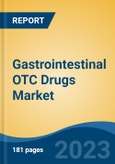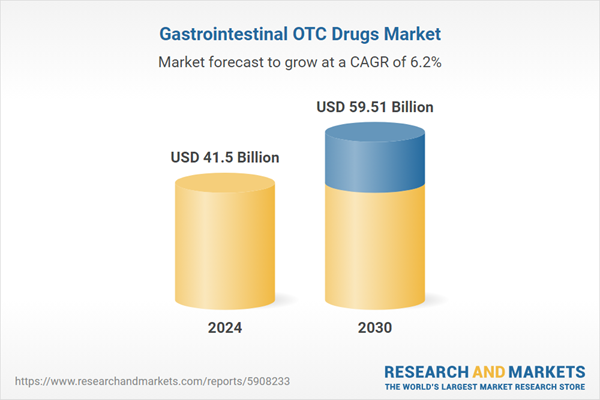Speak directly to the analyst to clarify any post sales queries you may have.
10% Free customizationThis report comes with 10% free customization, enabling you to add data that meets your specific business needs.
OTC drugs are typically used as directed on the packaging or as advised by a healthcare professional. Gastrointestinal OTC drugs are considered safe and effective when used according to the labeled instructions. Their non-prescription status reflects their suitability for self-medication by individuals experiencing mild to moderate gastrointestinal symptoms. However, individuals with severe or chronic gastrointestinal conditions should seek guidance from a healthcare provider.
The global aging population is more susceptible to gastrointestinal issues. As people age, they are more likely to experience digestive problems, which increases the need for OTC gastrointestinal remedies. Increasing awareness among consumers about gastrointestinal health and related issues encourages them to seek OTC solutions for common digestive problems. Educational campaigns and information dissemination contribute to this awareness.
Factors like poor dietary habits, stress, sedentary lifestyles, and irregular eating patterns contribute to gastrointestinal problems. These lifestyle factors drive the demand for OTC drugs to alleviate symptoms. OTC drugs offer a non-invasive and cost-effective means of managing common gastrointestinal issues. Many individuals prefer OTC options before considering prescription medications or medical procedures. Pharmaceutical companies continue to innovate by developing new formulations of OTC gastrointestinal drugs, such as fast-acting or long-lasting relief options, chewable tablets, and liquid formulations, to cater to consumer preferences.
Key Market Challenges
Generic Competition
Generic gastrointestinal OTC drugs typically cost less than their branded counterparts. This price competition can lead to lower profit margins for pharmaceutical companies that market branded OTC drugs, as consumers often opt for more affordable generic options. Some gastrointestinal OTC drugs have been on the market for a long time, and they may have multiple generic equivalents. This can lead to market saturation, with numerous generic products vying for a share of the market. When a branded OTC drug's patent expires, it opens the door for generic manufacturers to enter the market with their versions of the drug. As a result, the branded drug may experience a decline in market share.The presence of generic competitors can put pressure on branded OTC drug manufacturers to lower their prices, reducing their profitability. They may need to engage in price wars to maintain their market share. Generic drugs are generally perceived as cost-effective alternatives to branded drugs. This perception can lead consumers to switch from branded to generic OTC drugs when available, contributing to the challenges faced by branded manufacturers. Generic drugs must meet regulatory standards for safety, efficacy, and quality, just like branded drugs. Branded manufacturers may face increased scrutiny and competition from generic companies that adhere to these standards.
Branded OTC drug manufacturers often invest heavily in marketing and promotional efforts to differentiate their products. However, generic competitors may not invest as much in marketing, relying on price advantage instead. When a branded OTC drug's patent protection or exclusivity period expires, it allows generic manufacturers to introduce their versions. This can lead to a rapid loss of market exclusivity for branded drugs.
Key Market Trends
Natural and Herbal Remedies
Many consumers prefer natural and herbal remedies for gastrointestinal problems because they perceive them as gentler and having fewer side effects compared to synthetic drugs. A growing awareness of holistic health and wellness has encouraged individuals to seek natural and herbal solutions to address the root causes of gastrointestinal issues rather than just managing symptoms. Natural and herbal OTC products often contain plant-based ingredients known for their digestive benefits. Examples include ginger, peppermint, chamomile, aloe vera, and licorice. Probiotic supplements and prebiotic fiber sources have gained popularity for promoting gut health.These products are often considered natural and may be incorporated into OTC gastrointestinal offerings. Homeopathic remedies using highly diluted natural substances are used by some consumers to address digestive discomfort and gastrointestinal conditions. Natural and herbal remedies are often associated with fewer adverse effects, making them appealing to individuals who want to avoid the potential side effects of synthetic medications. Manufacturers have expanded their product lines to include a wide variety of natural and herbal OTC options for different gastrointestinal symptoms, such as herbal teas, dietary supplements, and herbal extracts. Some natural and herbal OTC products combine multiple ingredients to target multiple aspects of gastrointestinal health. For example, a product may include both ginger and fennel to address digestive discomfort and bloating.
Key Market Players
- Viatris Inc.
- Sandoz Group AG
- Johnson & Johnson Services, Inc.
- Sun Pharmaceuticals Industries Limited
- Teva Pharmaceuticals Industries Ltd.
- Zydus Life science Ltd.
- Sanofi SA
- Bayer AG
- Pfizer Inc.
- GlaxoSmithKline Plc.
Report Scope:
In this report, the Global Gastrointestinal OTC Drugs Market has been segmented into the following categories, in addition to the industry trends which have also been detailed below:Gastrointestinal OTC Drugs Market, By Drug Class:
- Laxatives
- Gastrointestinal Cancer Treatments
- Gastric Acid Reducers
- Anti-Diarrheal
- Proton Pump Inhibitors
- H2 Inhibitors
- Gastric Acid Neutralizers
- Bowel Anti-Inflammatory
- Anti-Emetics
Gastrointestinal OTC Drugs Market, By Indication:
- Gastroesophageal Reflux Disease or Heartburn
- Constipation
- Diarrhea
- Motion Sickness
- Others
Gastrointestinal OTC Drugs Market, By End User:
- Hospitals Pharmacies
- Retail Pharmacies
- Online pharmacies
- Others
Gastrointestinal OTC Drugs Market, By Region:
- North America
- United States
- Canada
- Mexico
- Europe
- France
- United Kingdom
- Italy
- Germany
- Spain
- Asia-Pacific
- China
- India
- Japan
- Australia
- South Korea
- South America
- Brazil
- Argentina
- Colombia
- Middle East & Africa
- South Africa
- Saudi Arabia
- UAE
Competitive Landscape
Company Profiles: Detailed analysis of the major companies present in the Global Gastrointestinal OTC Drugs Market.Available Customizations:
With the given market data, the publisher offers customizations according to a company's specific needs. The following customization options are available for the report.Company Information
- Detailed analysis and profiling of additional market players (up to five).
This product will be delivered within 1-3 business days.
Table of Contents
Companies Mentioned
- Viatris Inc.
- Sandoz Group AG
- Johnson & Johnson Services, Inc.
- Sun Pharmaceuticals Industries Limited
- Teva Pharmaceuticals Industries Ltd.
- Zydus Life science Ltd.
- Sanofi SA
- Bayer AG
- Pfizer Inc.
- GlaxoSmithKline Plc.
Table Information
| Report Attribute | Details |
|---|---|
| No. of Pages | 180 |
| Published | February 2025 |
| Forecast Period | 2024 - 2030 |
| Estimated Market Value ( USD | $ 41.5 Billion |
| Forecasted Market Value ( USD | $ 59.51 Billion |
| Compound Annual Growth Rate | 6.1% |
| Regions Covered | Global |
| No. of Companies Mentioned | 10 |









